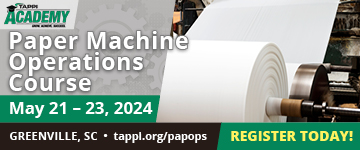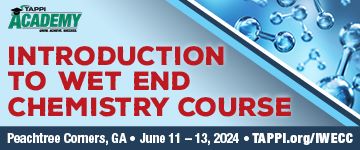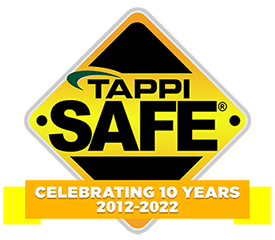 Search
Search
Use the search bar or filters below to find any TAPPI product or publication.
Filters
Content Type
Publications
Level of Knowledge
Collections
Journal articles

Magazine articles

Editorial: Reflections on the Page equation, laboratory work, and new concepts, TAPPI Journal May 2022
ABSTRACT: I began teaching paper physics to undergraduates in the late 1980s when the recognized giants in the field were still actively debating their subjects in the literature and scientific conferences.
Journal articles

Magazine articles

Water chemistry challenges in pulping and papermaking • fundamentals and practical insights: Part 2: Conductivity, charge, and hardness, TAPPI Journal June 2023
ABSTRACT: Although water is essential to the papermaking process, papermakers often overlook its importance and focus on fibers, fillers, and chemical additives. A better understanding of water properties and chemical interactions associated with water at the wet end leads to a sound foundation for high-quality paper production and smooth operation. Water is an excellent solvent for ionic substances, both organic and inorganic. These substances contribute to system conductivity, charge, and hardness and significantly impact the papermaking process. Part 1 of this paper, published in TAPPI J. 21(6): 313(2022), discussed fundamental water properties, water chemistry, and the impact of pH on pulping and papermaking operations. In this paper, we review definitions, sources, and the typical symptoms of the effect of conductivity, charge, and hardness on the productivity of the papermaking process. Sources of conductivity, charge, and hardness impacting these factors, measurement methods, and available correction strategies for their control are also discussed.
Journal articles

Magazine articles

Development of reinforced paper and mitigation of the challenges of raw material availability by utilizing Areca nut leaf, TAPPI Journal September 2022
ABSTRACT: Paper industries are facing a raw material crisis and searching for alternate raw materials that may be able to help mitigate the issue. Many industries use agro-waste as a raw material, irrespective of it having low bleachability and poor mechanical strength. Areca nut leaf (ANL) is a nonwood-based material that may be acceptable as an alternate source of raw material that contains 61.5% holocellulose and 13.6% lignin, which is comparable to other agro-wastes and hardwood pulps. Kraft anthraquinone pulping with 20% active alkali as sodium oxide (Na2O), 25% sulfidity, and 0.05% anthraquinone produced 15 kappa pulps with about 38.5% pulping yield. The bleachability of ANL pulp was good, and 83.5% ISO brightness could be achieved using the D0(EOP)D1 bleaching sequence. The ANL fiber has 33.8% better tensile, 54.5% better tear, and 15.2% better burst index than hardwood fiber. Similarly, 60.4% better tensile, 56.5% better tear, and 21.7% better burst index were observed in ANL than in wheat straw. Thus, the study revealed that Areca nut leaf can be used as an alternative raw material for papermaking, as well as to improve the physical property of paper products by blending it with inferior quality pulp.
Journal articles

Magazine articles

Improvements in oil and grease resistance (OGR) test methodology for waterborne barrier coatings, TAPPI Journal November 2022
ABSTRACT: Paper-based food packaging is becoming more popular due to consumer demands for sustainable packaging options. Waterborne paper coatings that provide performance properties (i.e., resistance to oil and grease) not inherent to paper and board substrates offer improved sustainability profiles over earlier paper treatment options, including fluorocarbon treatment and coating with extruded plastics. The continued development of new paper coating technologies requires re-evaluation of current test methods and development of new methods to ensure lab evaluations can serve as accurate predictors of real-world performance. This paper provides an overview of commonly used oil and grease resistance (OGR) test methods within the paper coatings industry, and then describes improvements and developments made to two key methods: the 3M Kit test and an internally developed oil breakthrough test. The combined use of these adapted methods provides a more efficient testing workflow and a more complete understanding of the OGR performance of barrier coatings.
Journal articles

Magazine articles

Editorial: The road to sustainable packaging: New research on aqueous barrier coating, TAPPI Journal November 2022
ABSTRACT: This TAPPI Journal Special Coating Issue looks at hot topic research being done in coatings for paper and paperboard. We can feel the “earth shifting” in paper and paper-board packaging due to the strong call by consumers and brand owners for more sustainable and environmentally friendly options. This is the first TAPPI Journal Special Coating Issue to highlight efforts within the paper coating community to produce more sustainable packaging.
Journal articles

Magazine articles

Fiber-based characterization of pulp refining, TAPPI Journal September 2022
ABSTRACT: Fiber development in pulp refining can be characterized by three parameters: number of impacts on pulp, N; energy per impact, I, and bar force on fibers, F. These parameters enable comparisons of radically different refining conditions; determination of intensity for hardwoods and softwoods; assessment of effect of bar width on fiber shortening; and predictions of tensile strength increases.
Journal articles

Magazine articles

The Creep Properties of Paper, TAPPI Journal August 2022
ABSTRACT: The creep proprties of alpha-pup handshetts were determined at various constant tensile loads and relative humidities for the purpose of clarifying the prerupture mechanical behavior of paper.
Journal articles

Magazine articles

Guest Editorial: Recognizing excellence in recycling, TAPPI
Guest Editorial: Recognizing excellence in recycling, TAPPI JOURNAL February 2012
Journal articles

Magazine articles

Commercially relevant water vapor barrier properties of high amylose starch acetates: Fact or fiction?, TAPPI Journal September 2021
ABSTRACT: Starches have recently regained attention as ecofriendly barrier materials due to the increased demand for sustainable packaging. They are easily processable by conventional plastics processing equipment and have been utilized for oil and grease barrier applications. While starches have excellent oxygen barrier properties and decent water barrier properties at low relative humidity (RH), they are moisture sensitive, as demonstrated by the deterioration of the barrier properties at higher RH values. Starch esters are chemically modified starches where the hydroxyl group of the starch has been substituted by other moieties such as acetates. This imparts hydrophobicity to starches and has been claimed as a good way of retaining water vapor barrier properties of starches, even at high RH conditions. We studied the water vapor barrier properties of one class of starch esters, i.e., high amylose starch acetates that were assumed to have good water vapor barrier properties. Our investigations found that with a high degree of substitution of hydroxyl groups, the modified starches did indeed show improvements in water vapor response as compared to pure high amylose starch films; however, the barrier properties were orders of magnitude lower than commercially used water vapor barriers like polyethylene. Even though these materials had improved water vapor barrier response, high amylose starch acetates are likely unsuitable as water vapor barriers by themselves, as implied by previous literature studies and patents.
Journal articles

Magazine articles

Boiler retrofit improves efficiency and increases biomass firing rates, TAPPI Journal March 2021
ABSTRACT: Domtar’s fluff pulp mill in Plymouth, NC, USA, operates two biomass/hog fuel fired boilers (HFBs). For energy consolidation and reliability improvement, Domtar wanted to decommission the No. 1 HFB and refurbish/retrofit the No. 2 HFB. The No. 2 HFB was designed to burn pulverized coal and/or biomass on a traveling grate. The steaming capacity was 500,000 lb/h from coal and 400,000 lb/h from biomass. However, it had never sustained this design biomass steaming rate. As the sole power boiler, the No. 2 HFB would need to sustain 400,000 lb/h of biomass steam during peak loads. An extensive evaluation by a combustion and boiler technologies supplier was undertaken. The evaluation involved field testing, analysis, and computational fluid dynamics (CFD) modeling, and it identified several bottle-necks and deficiencies to achieving the No. 2 HFB’s biomass steam goal. These bottlenecks included an inadequate combustion system; insufficient heat capture; excessive combustion air temperature; inadequate sweetwater con-denser (SWC) capacity; and limited induced draft fan capacity.To address the identified deficiencies, various upgrades were engineered and implemented. These upgrades included modern pneumatic fuel distributors; a modern sidewall, interlaced overfire air (OFA) system; a new, larger economizer; modified feedwater piping to increase SWC capacity; replacement of the scrubber with a dry electrostatic precipitator; and upgraded boiler controls.With the deployment of these upgrades, the No. 2 HFB achieved the targeted biomass steaming rate of 400,000 lb/h, along with lowered stack gas and combustion air temperatures. All mandated emissions limit tests at 500,000 lb/h of steam with 400,000 lb/h of biomass steam were passed, and Domtar reports a 10% reduction in fuel firing rates, which represents significant fuel savings. In addition, the mill was able to decommission the No. 1 HFB, which has substantially lowered operating and maintenance costs.






